Nestled at the mouth of Donegal Bay, with the Blue Stack Mountains as its backdrop, Donegal Town stands as a reminder of Ireland’s rich and complex history. From its early Gaelic settlements and Viking invasions to its prominence as the seat of the powerful O’Donnell clan, through periods of English control, famine, and modernization, Donegal Town has continually adapted while preserving its unique cultural heritage. This article explores the town’s journey through time, from its ancient roots to its current status as a vibrant tourist destination, highlighting key historical events, architectural landmarks, and cultural contributions that have shaped not only the town but also played a significant role in the broader tapestry of Irish history and culture. Join us as we uncover the layers of history that make Donegal Town a microcosm of Ireland’s past and a window into its future.
Contents
Early Settlement and Viking Era
The area now known as Donegal Town has a rich history of human settlement dating back to ancient times. Archaeological evidence suggests that people have inhabited this region since at least the Neolithic period, around 2000 BC. The strategic location at the mouth of the River Eske and Donegal Bay, nestled beneath the Blue Stack Mountains, made it an attractive site for early settlers.
The Gaels established a presence in the area approximately 2000 years ago, creating the foundations for what would eventually become an important center of Gaelic culture and power. However, it was the arrival of the Norse Vikings in the 8th and 9th centuries that gave Donegal Town its name and shaped its early development.
The Vikings recognized the strategic importance of the site, using it as a port and establishing a settlement. The name “Donegal” itself comes from the Irish “Dún na nGall,” meaning “Fort of the Foreigners,” likely referring to this Viking presence. In 807 AD, the “Annals of Tirchonaill” record the presence of Vikings in Donegal Bay, indicating their significant influence in the area.
The Vikings’ impact on Donegal was not just in name; they contributed to the development of the town as a trading post, leveraging its excellent natural harbor. This laid the groundwork for Donegal’s future importance as a center of commerce and power.
Evidence of this early period can still be seen in the landscape around Donegal Town. The remains of several earthen forts overlooking the town are thought to date from this era, possibly including early Danish fortifications. One such fortress was reportedly destroyed in 1159 by Murtagh Mac Lochlainn, High King of Ireland, demonstrating the ongoing conflicts and power struggles in the region during this period.
This early history set the stage for Donegal Town’s emergence as a significant settlement, blending Gaelic and Norse influences. The Viking era laid the foundation for the town’s future role as a center of power, trade, and culture under the O’Donnell dynasty in the centuries to come.
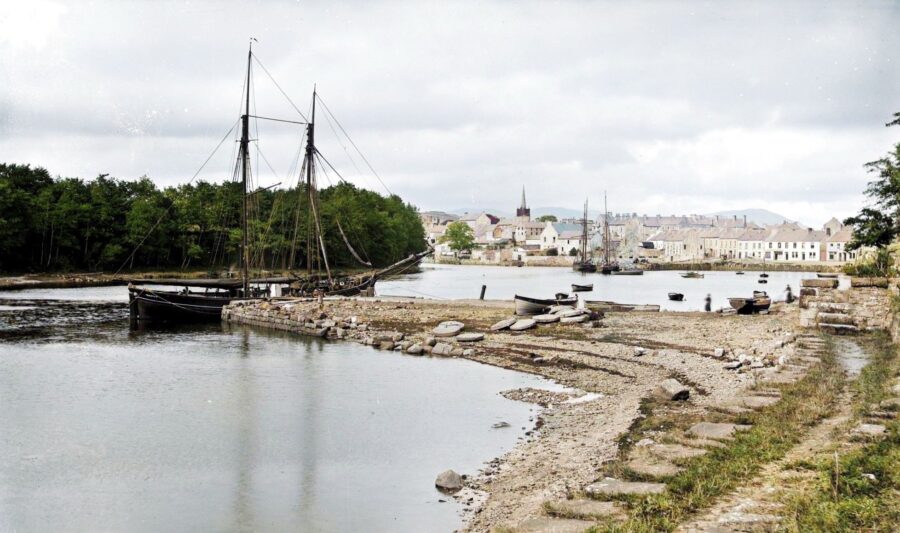
The Rise of the O’Donnell Dynasty (1200-1600)
The period from 1200 to 1600 AD marked the ascendancy of the O’Donnell clan, transforming Donegal Town from a modest settlement into the capital of a powerful Gaelic kingdom. This era saw Donegal emerge as the ruling seat of Tír Chonaill (Tyrconnell), encompassing much of present-day County Donegal.
The O’Donnells, a branch of the Northern Uí Néill dynasty, rose to prominence in the 13th century. They established their stronghold in Donegal Town, recognizing its strategic importance at the mouth of the River Eske and Donegal Bay. Under their rule, Donegal Town became the center of political, economic, and cultural life in northwest Ireland.
Key developments during this period included:
- Construction of Donegal Castle: The first Red Hugh O’Donnell and his wife, Nuala O’Brien, built the original Norman-style tower house in 1474. This castle became the seat of O’Donnell power and a symbol of their authority.
- Patronage of the Franciscan Order: In 1474, the same year as the castle’s construction, the O’Donnells founded the Franciscan Friary (Donegal Abbey). This act demonstrated their commitment to religious and cultural development in the region.
- Expansion of Trade: The O’Donnells leveraged Donegal’s natural harbor to develop extensive trade networks. They became known as the “Lords of the Fish” due to their control over the lucrative fishing industry in Donegal Bay.
- Cultural Flourishing: Under O’Donnell patronage, Donegal became a center of Gaelic learning and culture. This culminated in the later creation of the “Annals of the Four Masters,” a comprehensive history of Ireland begun in Donegal.
- Military Prowess: The O’Donnells successfully defended their territory against both rival Gaelic clans and English incursions for several centuries, maintaining their independence and power.
The apex of O’Donnell power came under the second Red Hugh O’Donnell (1572-1602). A charismatic leader, he led resistance against English expansion in the Nine Years’ War (1593-1603). However, defeat at the Battle of Kinsale in 1601 marked the beginning of the end for O’Donnell rule.
The O’Donnell dynasty’s control over Donegal came to an end with the Flight of the Earls in 1607. Rory O’Donnell, along with other Gaelic lords, left Ireland for mainland Europe, seeking support to continue their fight against English rule. This event marked the end of the Gaelic order in Ulster and paved the way for the Plantation of Ulster.
Donegal Castle and Franciscan Abbey
Donegal Castle and the Franciscan Abbey stand as two of the most significant historical structures in Donegal Town, both dating back to 1474 and closely tied to the O’Donnell dynasty.
Donegal Castle:
Built in 1474 by the first Red Hugh O’Donnell and his wife, Nuala O’Brien, Donegal Castle served as the stronghold of the O’Donnell clan. Its strategic location at a bend in the River Eske provided natural defenses on two sides. The castle initially consisted of a tall, square keep with thick walls, typical of the Norman-style tower houses of the period.
After the Flight of the Earls in 1607, the castle fell into English hands. Sir Basil Brooke acquired it around 1611 and carried out major reconstruction work, adding a large Jacobean-style wing to the original tower. This expansion transformed the defensive stronghold into a more comfortable manor house, reflecting the changing political landscape.
The castle fell into ruin in the 18th century but has since been extensively restored by the Office of Public Works. Today, it stands as a prime example of both Gaelic and Jacobean architecture.
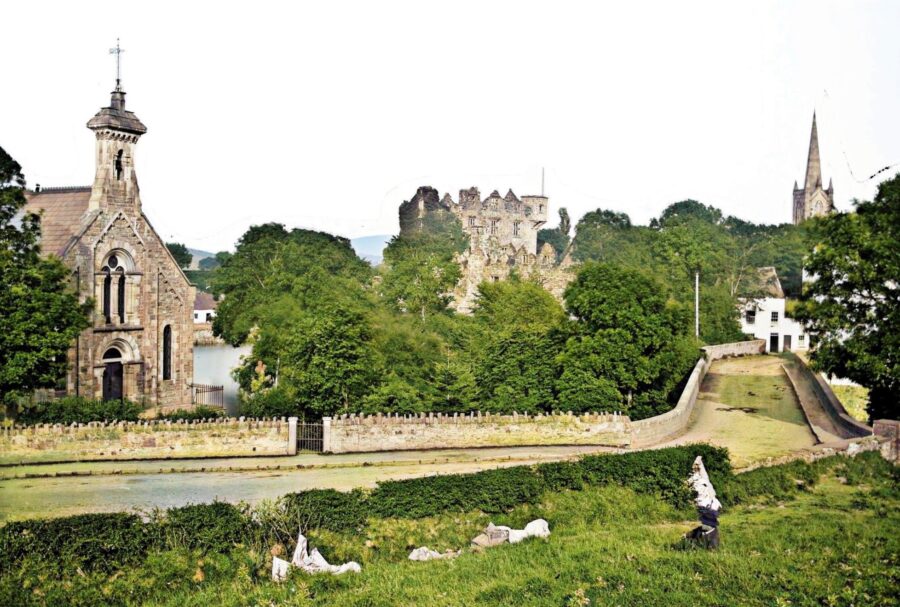
Franciscan Abbey:
Also founded in 1474 by the first Red Hugh O’Donnell and Nuala O’Brien, the Franciscan Abbey (also known as Donegal Friary) played a crucial role in the religious and cultural life of medieval Donegal. The Abbey followed the typical Franciscan layout with the church on the south side and cloisters and conventual buildings to the north.
The Abbey became a center of learning and culture. Its most famous contribution to Irish history came in the 1630s when it became the site where the “Annals of the Four Masters” were conceived and begun. This comprehensive history of Ireland, compiled by Franciscan friars, remains one of the most important historical writings in Irish history.
The Abbey’s fortunes were tied closely to those of the O’Donnells. In 1601, during the Nine Years’ War, it was turned into a fortress by Niall Garbh O’Donnell when he and his English allies were besieged by Red Hugh O’Donnell. This military use led to significant damage to the structure.
Following the Flight of the Earls in 1607, the Abbey and its possessions were confiscated by the English crown. The buildings fell into ruin, and today, only parts of the original structure remain, including sections of the cloister.
The Flight of the Earls and English Control
The Flight of the Earls in 1607 marked a pivotal moment in the history of Donegal Town and Ireland as a whole, signaling the end of the Gaelic order and ushering in an era of English control.
Following the Nine Years’ War (1593-1603) and the defeat of the Irish forces at the Battle of Kinsale in 1601, the power of the Gaelic lords was significantly weakened. Hugh O’Neill, Earl of Tyrone, and Rory O’Donnell, Earl of Tyrconnell (brother of Red Hugh O’Donnell), found themselves in an increasingly precarious position under the rule of the newly crowned King James I.
Faced with diminishing authority and fearing arrest by Lord Chichester, the earls made the fateful decision to leave Ireland. In September 1607, O’Neill, O’Donnell, and about 90 of their followers set sail from Rathmullan in County Donegal, intending to seek Spanish support for a new rebellion. This event became known as the Flight of the Earls.
The consequences for Donegal Town and the surrounding area were profound:
- End of O’Donnell Rule: The departure of Rory O’Donnell effectively ended the centuries-long rule of the O’Donnell clan over Donegal.
- Confiscation of Lands: The earls’ flight was treated as treason, leading to the confiscation of their vast estates by the English crown.
- Plantation of Ulster: The Flight of the Earls paved the way for the Plantation of Ulster, a organized colonization by Protestant English and Scottish settlers.
- Change of Ownership: Donegal Castle and the surrounding lands were granted to English Captain Basil Brooke around 1611.
- Architectural Changes: Brooke extensively renovated Donegal Castle, adding a Jacobean wing to the original Gaelic tower house, symbolizing the shift in power.
- Urban Development: Brooke also laid out the current plan of Donegal Town, including the Diamond (central square), reflecting English town planning principles.
- Cultural Shift: The influx of Protestant settlers began to change the cultural and religious landscape of the area.
The transition to English control was not immediate or smooth. There were periods of resistance and conflict, including during the 1641 rebellion and the Williamite Wars. However, by the end of the 17th century, English authority was firmly established.
Under English rule, Donegal Town continued to develop as a market town. In 1612, it was granted a royal charter, allowing it to return two MPs to the Irish Parliament. This period saw the town’s role shift from a center of Gaelic power to a provincial market town within the broader English administrative system.
Development as a Market Town
Following the Flight of the Earls and the establishment of English control, Donegal Town transitioned from a seat of Gaelic power to a thriving market town. This transformation was crucial in shaping the town’s character and economy in the centuries that followed.
Key developments in Donegal’s evolution as a market town included:
- Royal Charter: In 1612, Donegal was granted a royal charter by King James I. This charter gave the town corporate status and the right to hold markets and fairs, as well as to return two Members of Parliament to the Irish Parliament.
- Town Planning: Sir Basil Brooke, who acquired Donegal Castle after the Flight of the Earls, played a significant role in planning the town’s layout. He designed the Diamond, the central square that became the heart of commercial activity in Donegal.
- The Diamond: This triangular market place became the focal point of the town. Regular markets were held here, attracting traders and buyers from the surrounding countryside. The Diamond continued to serve as a vibrant marketplace well into the 20th century, with livestock and goods being traded as late as the 1950s.
- Diverse Trade: Donegal’s position at the mouth of the River Eske and Donegal Bay made it an ideal location for trade. The town became known for its fishing industry, textile production (particularly Donegal tweed), and agricultural trade.
- Fair Days: Monthly fair days became a significant feature of life in Donegal Town. These were not just commercial events but also important social occasions where people from the surrounding rural areas would gather to trade, socialize, and exchange news.
- Infrastructure Development: To support its role as a market town, Donegal saw improvements in roads and bridges, facilitating easier access for traders and visitors.
- Growth of Services: The town’s market function led to the growth of related services such as inns, taverns, and shops, contributing to a more diverse urban economy.
- Cultural Impact: The market town status attracted a mix of people to Donegal, including English and Scottish settlers, leading to a blend of cultural influences.
- Architectural Development: The town’s prosperity as a market center led to the construction of new buildings, including townhouses and commercial premises, many of which still stand today.
- Economic Resilience: While the fortunes of Donegal Town fluctuated over the centuries, its role as a market town provided a degree of economic stability and continuity.
The development of Donegal as a market town was crucial in maintaining its importance following the end of Gaelic rule. It transformed the town from a seat of feudal power to a center of commerce and exchange, laying the foundations for its modern identity.
This market town heritage is still evident in Donegal today. The Diamond remains the heart of the town, surrounded by shops and businesses. While the nature of commerce has changed, Donegal Town’s layout and character continue to reflect its long history as a market center, blending this heritage with its role as a modern tourist destination and regional hub.
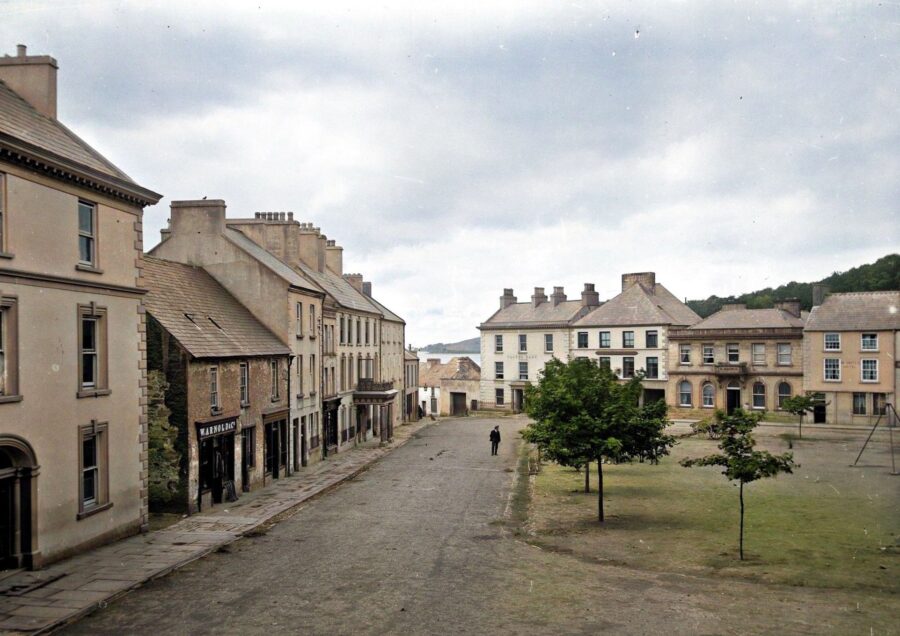
Notable Historical Events
The Spanish Armada:
In 1588, Donegal Bay played a small but significant role in the story of the Spanish Armada. Following the defeat of the Spanish fleet by the English, several ships were wrecked along the Irish coast as they attempted to return to Spain.
One such ship, the San Martin, found itself in trouble near Donegal Town. Local tradition holds that the ship was abandoned as a wreck near Donegal Harbour. While the exact details are unclear, this event connects Donegal to one of the most famous naval campaigns in European history.
The presence of the Armada ship off the Donegal coast likely caused considerable excitement and perhaps some apprehension among the local population. At the time, many Irish chieftains, including the O’Donnells, were sympathetic to the Spanish cause against the English. However, helping the Spanish survivors was a risky proposition, as it could invite reprisals from the English authorities.
This event serves as a reminder of Donegal’s strategic coastal location and its place within the broader context of European conflicts of the 16th century.
The 1798 Rebellion:
The 1798 Rebellion, a major uprising against British rule in Ireland, also left its mark on Donegal Town. While Donegal was not a major center of the rebellion, it was touched by events related to the conflict.
One of the most notable incidents occurred in October 1798, involving a French invasion fleet sent to support the Irish rebels. Three French frigates, part of a squadron from Brest, anchored in Donegal Bay on October 13, 1798. One of these ships was the Romaine.
Upon learning that General Humbert’s army in Mayo had already surrendered and observing English militia on shore, the captain of the Romaine made a quick decision. He cut the ship’s cable, abandoning the anchor, and sailed back to France.
This abandoned anchor became a tangible piece of history for Donegal Town. Today, a large anchor believed to be from the Romaine is displayed on the harbor green in Donegal Town. The plaque accompanying the anchor reads:
“This anchor probably belonged to the frigate Romaine, which was one of a French squadron out of Brest on the 16th September 1798, in support of General Humbert’s army in Mayo. Wolfe Tone sailed with the squadron. Following engagements with English naval forces off the Donegal coast, the Romaine, with two sister ships, anchored in Donegal Bay on the 13th of October 1798. Learning of Humbert’s surrender and observing English militia on shore, the Romaine cut her cable, leaving her anchor and sailed back to France.”
This event connects Donegal Town to the broader narrative of the 1798 Rebellion and the international dimension of the conflict, with French support for the Irish rebels.
The Annals of the Four Masters
The Annals of the Four Masters, or “Annála Ríoghachta Éireann” (Annals of the Kingdom of Ireland) in Irish, is one of the most significant chronicles of Irish history. This monumental work has a deep connection to Donegal Town and represents a crucial part of the area’s cultural and historical legacy.
Compilation and Authors:
The Annals were compiled between 1632 and 1636 by a team of Franciscan friars working in the Franciscan friary in Donegal Town. The principal authors, known as the Four Masters, were:
- Mícheál Ó Cléirigh (chief author)
- Cú Choigcríche Ó Cléirigh
- Fearfeasa Ó Maol Chonaire
- Cú Choigcríche Ó Duibhgeannáin
Mícheál Ó Cléirigh, a Franciscan brother and the chief compiler, traveled around Ireland during the summer months gathering historical and mythological information. He would return to the friary in Donegal Town at the end of summer, where the winter months were spent correlating and writing up the collected information.
Content and Scope:
The Annals of the Four Masters is a comprehensive chronicle of Irish history from ancient times (allegedly from 2242 BC) to 1616 AD. It brings together material from a wide range of sources, including now-lost annals and manuscripts, creating a monumental record of Irish history, genealogy, and culture.
The work is written in Irish and represents one of the last great works of the Gaelic historiographical tradition before the final collapse of the Gaelic order in Ireland.
Significance:
- Historical Record: The Annals provide an invaluable record of Irish history, preserving information that might otherwise have been lost.
- Cultural Preservation: Compiled at a time when Gaelic culture was under threat, the Annals represent an effort to preserve Irish heritage and historical memory.
- Linguistic Importance: As a substantial work in the Irish language, the Annals are a significant linguistic resource.
- Local Pride: For Donegal Town, the Annals represent a point of pride, connecting the town to a work of national and international importance.
Legacy:
The original manuscripts of the Annals are now held in various locations, including Trinity College Dublin, University College Dublin, and the Royal Irish Academy. A partial copy can be viewed in the museum at the Franciscan Friary in Rossnowlagh, County Donegal.
In Donegal Town itself, the legacy of the Four Masters is commemorated by the obelisk in the Diamond, the town’s central square. This monument, made of Mountcharles sandstone, bears the names of the Four Masters and serves as a constant reminder of this remarkable historical work.
19th and 20th Century Donegal
The Great Famine:
The Great Famine of 1845-1852 had a profound impact on Donegal Town and the surrounding county, as it did throughout Ireland. This period of mass starvation, disease, and emigration dramatically altered the social and economic landscape of the region.
Key impacts on Donegal included:
- Population Decline: While exact figures for Donegal Town are unclear, the county as a whole saw a significant population decrease. Some areas, like Glencolmcille, lost over 70% of their population to starvation, disease, and emigration.
- Workhouses: A workhouse was established in Donegal Town to provide relief for the destitute. The buildings later became part of the local hospital.
- Famine Graves: On the Ballybofey road out of Donegal Town, there is a Famine Graveyard where victims of the famine are buried. This site serves as a somber reminder of the tragedy.
- Long-term Economic Impact: The famine led to long-lasting economic depression in the region, with many farms abandoned and local industries disrupted.
- Cultural Changes: The famine accelerated the decline of the Irish language in many areas and contributed to changing social structures.
- Emigration Legacy: Many families in Donegal can trace their history of emigration to the famine years, creating lasting connections with diaspora communities, particularly in America and Australia.
The Railway Era:
The late 19th and early 20th centuries saw the arrival of the railway in Donegal, which had a significant impact on the town and the wider county.
Key developments included:
- Donegal Railway Station: Opened on September 16, 1889, the station connected Donegal Town to the wider rail network. It remained operational until January 1, 1960.
- County Donegal Railways: Donegal was served by a narrow gauge railway system known as the County Donegal Railways. This network connected various towns in the county, with Donegal Town serving as an important junction.
- Economic Impact: The railway brought increased trade and tourism to Donegal Town, helping to boost the local economy. It facilitated the export of local products like Donegal tweed and brought more visitors to the area.
- Social Changes: The railway made travel easier for local people, connecting Donegal more closely with other parts of Ireland and beyond.
- Decline: The rise of road transport in the mid-20th century led to the gradual decline of the railway system. The last commercial boat left Donegal harbour in the 1960s, marking the end of an era.
- Heritage: Today, the site of the old railway station is used by CIÉ as a bus depot, while the station building houses the Donegal Railway Heritage Centre. This museum preserves the memory of the railway era, displaying artifacts, memorabilia, and photographs about the history of the railway in the county.
Modern Donegal Town
Tourism and Culture:
Modern Donegal Town has successfully leveraged its rich history and stunning natural surroundings to become a thriving tourist destination. The town’s culture is a unique blend of traditional Gaelic heritage and contemporary Irish life.
- Cultural Events: Donegal Town hosts numerous events throughout the year, including the St. Patrick’s Day Parade, Christmas Lights Switch On, Summer Festivals, and Regattas.
- Food Culture: The town has gained recognition for its culinary scene. In 2019, Donegal Town was named Ireland’s Foodiest Town. The annual “A Taste of Donegal Food Festival” has become a flagship event, establishing the area as a food lover’s destination.
- Music and Arts: Donegal has a strong tradition in music, with the distinctive sounds of bands like Clannad and Altan originating from the county. The town regularly hosts traditional music sessions in its pubs.
- Craft Heritage: The Donegal Craft Village showcases contemporary arts and crafts, continuing the region’s long tradition of textile production and other crafts.
- Language: While English is predominant, efforts are made to preserve the Irish language, which is still spoken in parts of the county.
Key Attractions:
Donegal Town offers a variety of attractions that draw visitors from around the world:
- Donegal Castle: This restored 15th-century castle, once the stronghold of the O’Donnell clan, is a major draw for history enthusiasts.
- The Diamond: The town’s central square, featuring the obelisk commemorating the Four Masters, is the heart of Donegal Town.
- Donegal Bay Waterbus: Offers tours of Donegal Bay, providing stunning views of the coastline and insights into local history.
- Franciscan Friary Ruins: Located at the end of the pier, these ruins are where the Annals of the Four Masters were written.
- Donegal Railway Heritage Centre: Housed in the old railway station, it preserves the history of the county’s railway era.
- Bank Walk: A popular 2.5 km path along the west bank of the River Eske, offering beautiful views and wildlife spotting opportunities.
- Magee of Donegal: This iconic tweed shop and visitor center showcases the area’s famous textile industry.
- Donegal Craft Village: A hub for local artisans, offering handmade crafts and art.
- The Anchor: This large 18th-century anchor on display near the harbor is linked to the 1798 rebellion.
- St. Patrick’s Church: An impressive Catholic church built in the 1930s in a mix of Irish Romanesque and Gothic styles.
- Lough Eske: A beautiful lake just outside town, home to Lough Eske Castle, now a luxury hotel.
- Donegal Golf Club: Located at Murvagh, this links course is considered one of the finest in Ireland.
Donegal Town has successfully transformed itself into a vibrant tourist destination while maintaining its rich cultural heritage. Its blend of historical sites, natural beauty, cultural events, and modern amenities makes it a popular base for exploring the wider Donegal region, solidifying its place on Ireland’s Wild Atlantic Way tourism route.
Donegal’s Place in Irish History and Culture
Donegal Town, and the wider County Donegal, occupy a unique and significant place in Irish history and culture. From ancient times to the present day, this northwestern corner of Ireland has played a crucial role in shaping the nation’s story.
Historical Significance:
- Gaelic Stronghold: As the seat of the O’Donnell clan, Donegal was a powerful Gaelic lordship that resisted English control longer than many other parts of Ireland.
- Flight of the Earls: The departure of the Gaelic lords from nearby Rathmullan in 1607 marked a turning point in Irish history, ending the old Gaelic order.
- Plantation Era: Donegal’s experience during the Plantation of Ulster provides insights into this transformative period in Irish history.
- Border Region: Following partition in 1921, Donegal’s unique position as part of the Republic but geographically connected to Northern Ireland has shaped its modern history and identity.
Cultural Contributions:
- The Annals of the Four Masters: This monumental work, compiled in Donegal Town, is one of the most important sources for early Irish history and culture.
- Language: Donegal preserves unique dialects of both Irish and English (including Ulster Scots in some areas), contributing to Ireland’s linguistic diversity.
- Music: The county has produced internationally renowned musicians and groups, including Clannad, Altan, and Enya, who have brought Donegal’s musical traditions to a global audience.
- Literature: Writers like Patrick MacGill have captured the Donegal experience in their work, while the county’s landscapes have inspired countless others.
- Craft Traditions: Donegal tweed and handknit sweaters are world-famous, representing Ireland’s textile heritage.
Contemporary Relevance:
- Tourism: As part of the Wild Atlantic Way, Donegal plays a crucial role in Ireland’s tourism industry, showcasing the country’s natural beauty and cultural heritage.
- Cultural Preservation: Efforts to maintain the Irish language and traditional crafts in Donegal contribute to the preservation of Ireland’s cultural heritage.
- Cross-border Relations: Donegal’s position provides a unique perspective on North-South relations in Ireland.
- Diaspora Connections: Like much of Ireland, Donegal maintains strong connections with its diaspora, particularly in Scotland, England, and North America.
- Environmental Significance: Donegal’s rugged coastline and diverse ecosystems make it an important site for conservation and environmental study in Ireland.
Donegal’s place in Irish history and culture is characterized by its role as a bastion of Gaelic culture, its experience of plantation and colonization, its unique border position, and its rich contributions to Irish music, literature, and craft traditions. The town and county embody many of the complexities of Irish history, from ancient times through colonization, famine, and modernization.
Today, Donegal continues to play a vital role in Irish culture, both as a preserver of traditions and as a dynamic, evolving community. Its blend of historical significance and contemporary relevance makes it an essential part of understanding the full breadth of Irish history and culture.


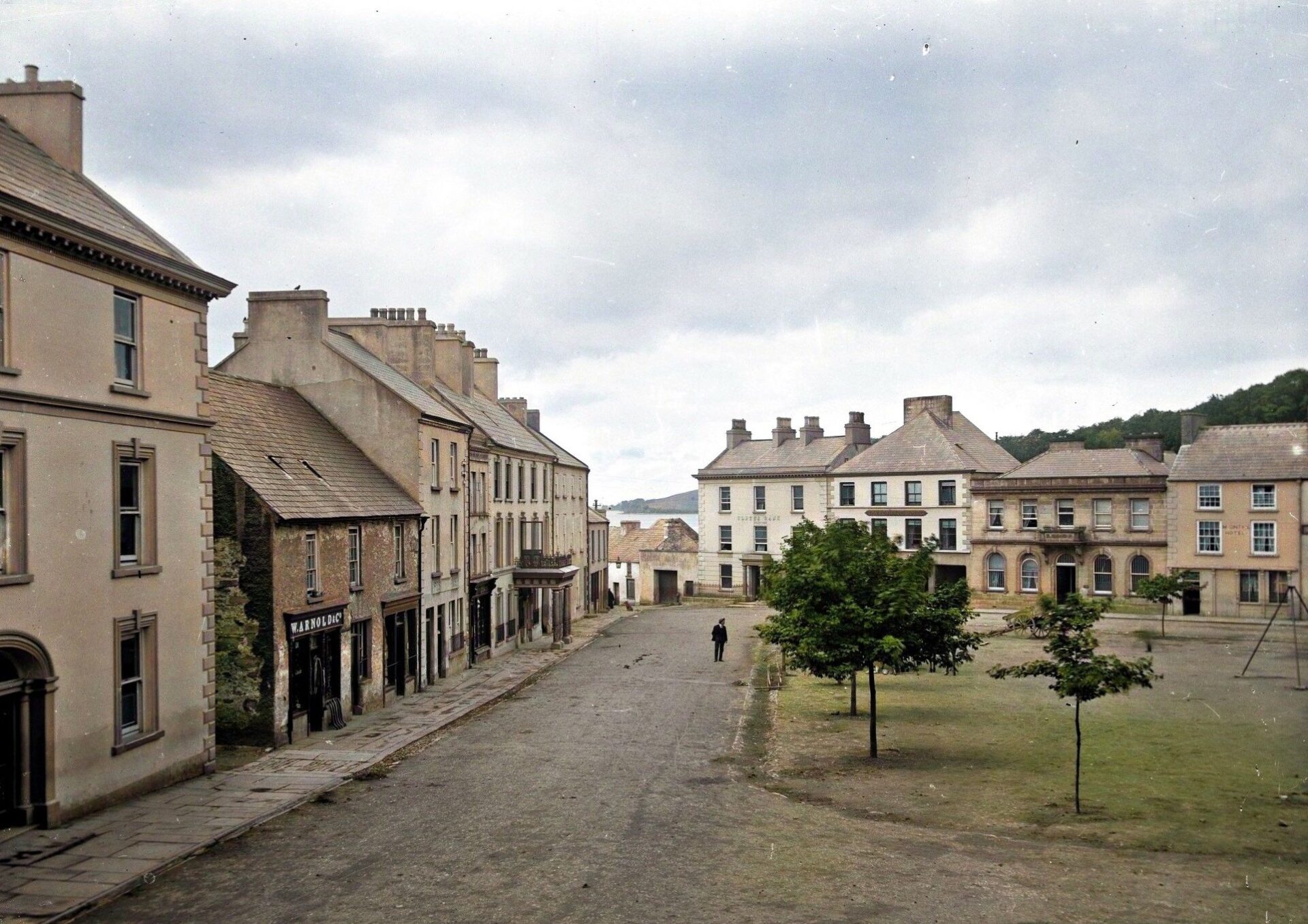
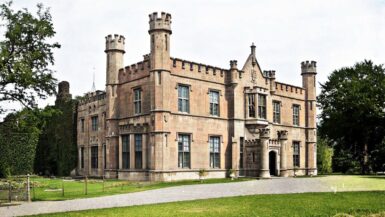
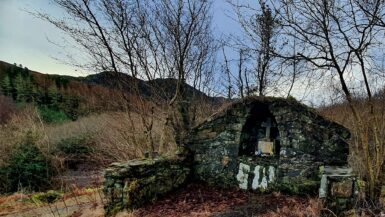
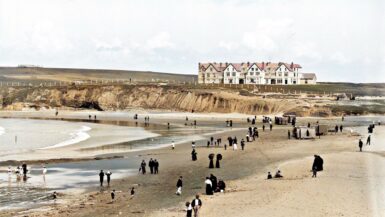
Leave a reply